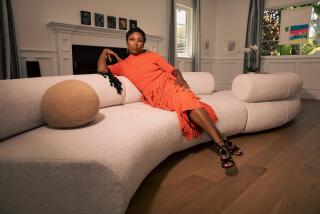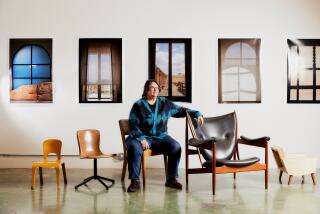Decorator Prefers Soul-Searching to Window-Shopping
- Share via
Most interior designers, when hired for their advice on upgrading a house, lead their clients on a furniture-buying binge. Not Alexandra Stoddard. “Light candles, play music, grow plants,” she advises. “Put a picture of yourself as a child in view somewhere, to remind yourself to be playful.”
The author of 21 books on home decorating that are read around the world, she sees an epidemic of clinical depression in America. “Look at the figures on Prozac. We are medicating ourselves when the real problem is a spiritual one.”
And the place where healing should occur, she believes, is in the home. “I see a lot of homeless people in their houses in this country. And I don’t find this in India, in Japan, in Taiwan.”
The Manhattan-based Stoddard was true to form in an interview earlier this week before her scheduled keynote speech at Wednesday’s WestWeek design trade conference opening in West Hollywood. Rather than the usual update on trendy colors or the growing passion for faux finishes, she elaborated on the message that earned her the title of “lifestyle lady” from House Beautiful magazine. It is a basic human need, she says, to create a home that is an emotional center, reflecting who you are and how you want to live.
In fact, Stoddard emphasizes, she is trying to get readers and audiences away from trends and into soul-searching. Yes, she takes people out to buy furniture, but that’s a small part of her interior-design philosophy.
“I feel very strongly we are spiritual beings in a physical body,” she explained, “and we should make our surroundings as beautiful and soulful as possible. If we could make our house a home, and then make it a sanctuary, I think we could truly find paradise on Earth.”
This motif, in one variation or another, has been her mantra for years in books, lectures and television appearances, which include hosting 39 episodes of “Homes Across America” for HGTV in 1995 and writing a McCall’s magazine column for five years.
Stoddard, 58, has been decorating since the early 1960s and has watched countless trends come and go: “I have seen carpeting going up the walls, the English country look so overdone you can’t see out the windows for the curtains, and bed hangings with enough material to give anyone an asthma attack.”
In a nation suffering from excess, she thinks that American consumers are vulnerable to fashion changes because they are directed outward--too prone to asking experts for help. As an interior designer, she decries what she sees as an ongoing “preparation for living,” as clients decorate and redecorate their houses aiming for the perfect look.
Rather, she says, home should be the ultimate symbol of self-actualization, a place where we exercise our creativity, work through emotional blocks and inhibitions and cultivate our intuitive powers.
The title of her latest book says it all: “Feeling at Home: Defining Who You Are and How You Want to Live,” (William Morrow, 1999).
The book, her trademark mix of practical interior-design tips and advice on creating a harmonious sanctuary, is a guide to living each day with greater joy, love and spontaneity. Stoddard is a great believer in experiencing the moment.
“How we feel about ourselves as we read the newspaper, set the table, wash the dishes, recycle the trash and wash our clothes . . . is essential to our overall happiness and well-being,” she writes.
The self-help book, sprinkled with dozens of maxims from poets, philosophers and novelists, demands participation from the reader.
To start, says Stoddard, make a list of the 10 symbols of things you like, things that define who you are. Emphasizing that every list is individual and personalized, she offers her own: “Love, sunlight, gardens, beaches, children, food, family, color, ribbons, home.”
*
Then work with this list to design your life and, in the process, your home. “Celebrate all that wonderful continuity!” she said. This might mean bringing some quilts out of the linen closet, or taking out the old linen napkins with your parents’ monograms on them.
“Stoddard has a genuine gift for thinking creatively about interior spaces,” wrote Publishers Weekly in reviewing “Feeling at Home.”
“The book bubbles with an infectious appreciation of even the smallest domestic pleasure and an inspiring awareness of the spiritual and emotional life of a house.”
Stoddard has been preaching personal fulfillment for years.
“My mother was an interior designer, and I love beauty and have always felt sort of compelled to help people,” she said.
Stoddard, recipient of the first full scholarship awarded by the New York School of Interior Design, graduated in 1961 and worked for 14 years with her mentor, designer Eleanor McMillen Brown. “Mrs. Brown said, ‘Do a good job and the money follows,’ ” Stoddard recalled. “I would rather inspire somebody than dictate what they should have in their living room.”
She started her own design firm 20 years ago and built a large practice, which she now has scaled back, spending most of her time “writing, studying, thinking and lecturing” on the art of living fully.
Her own life seems quite complete. She and her husband, lawyer Peter Megargee Brown, divide their time between a New York City apartment (“It’s filled with light and decorated in flower garden colors of red, orange, yellow and pale green”) and a “cozy, comfortable” cottage in Connecticut. Her two adult daughters, Alexandra B. Stoddard and Brooke Stoddard, are both journalists.
“I think as you mature, you really know what is important,” she said. “My husband and I are best friends. We are very, very connected.”
To illustrate her technique of creating a house as spiritual center, she devotes a chapter of her new book to a sample initial interview with a client family. The 35 pages of dialogue, which combine the skills of designer, detective and therapist, illustrate her belief that the role of a designer should be that of listener and facilitator, not fashion dictator.
*
“I often tell clients they don’t need new furniture, they need to go to a spa and meditate.” Of course, she added, she often takes people out to buy furniture.
“I love color and organic materials from the earth and I love silk for its wonderful sheen and feel. I like anything that helps my clients open up their five senses.” And, she hastened to say, she still believes that designers have a role to play today.
“I tell them they have a ministry. They go into houses, and by being a good listener and empathetic, they can help people. I would like to speak to every designer in America, because we are trying to make the world a more harmonious, more beautiful place.”
*
Connie Koenenn can be e-mailed at [email protected].


